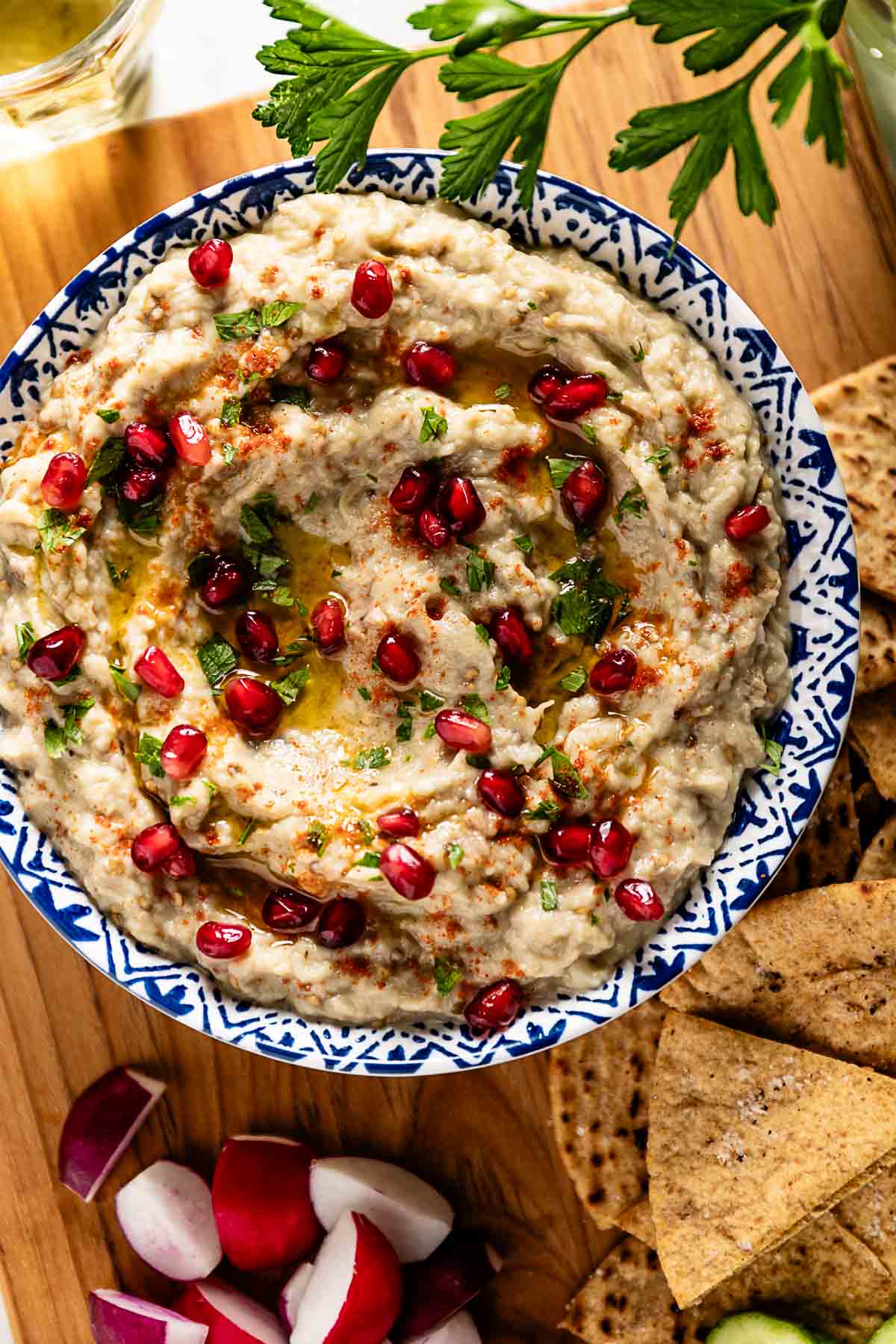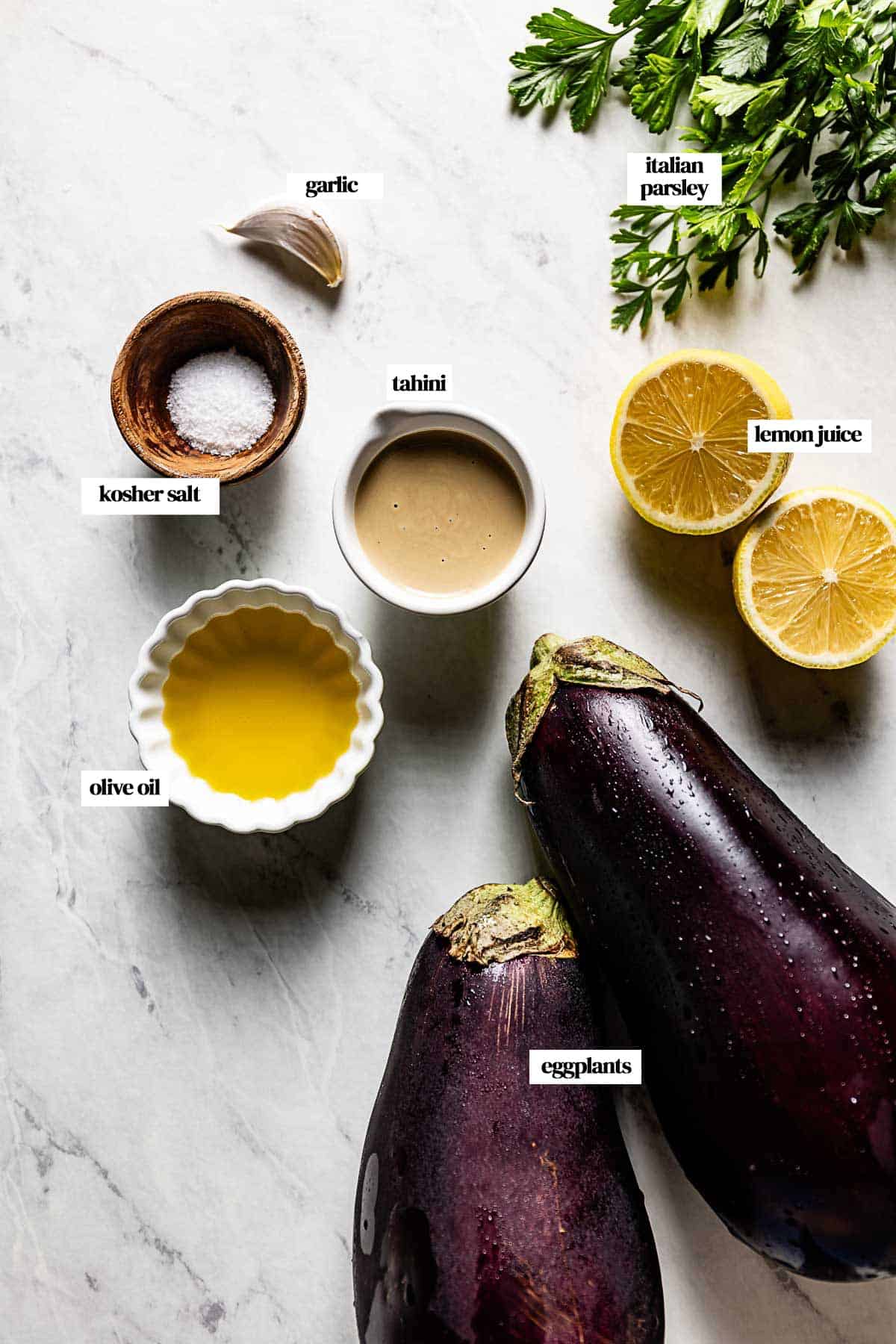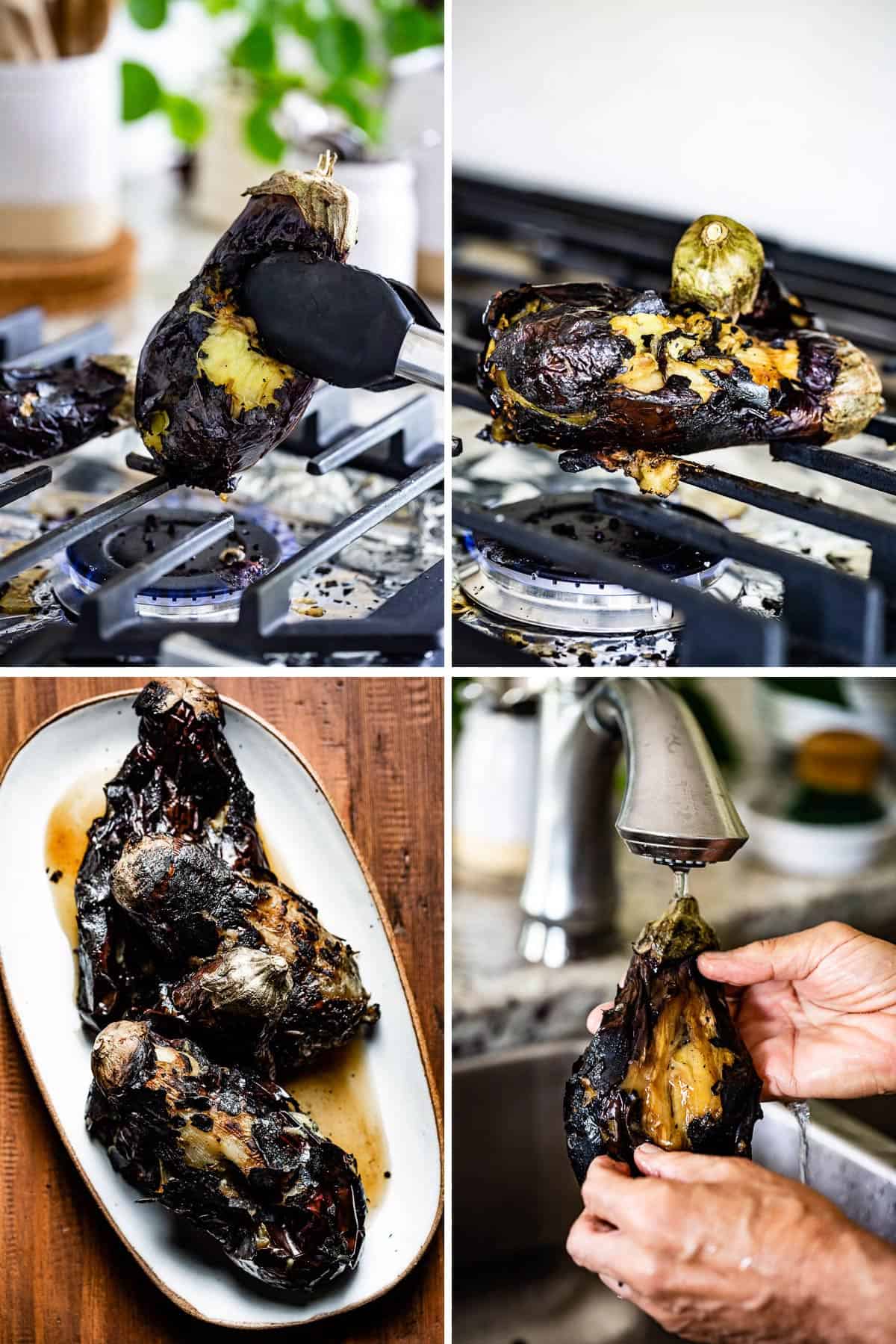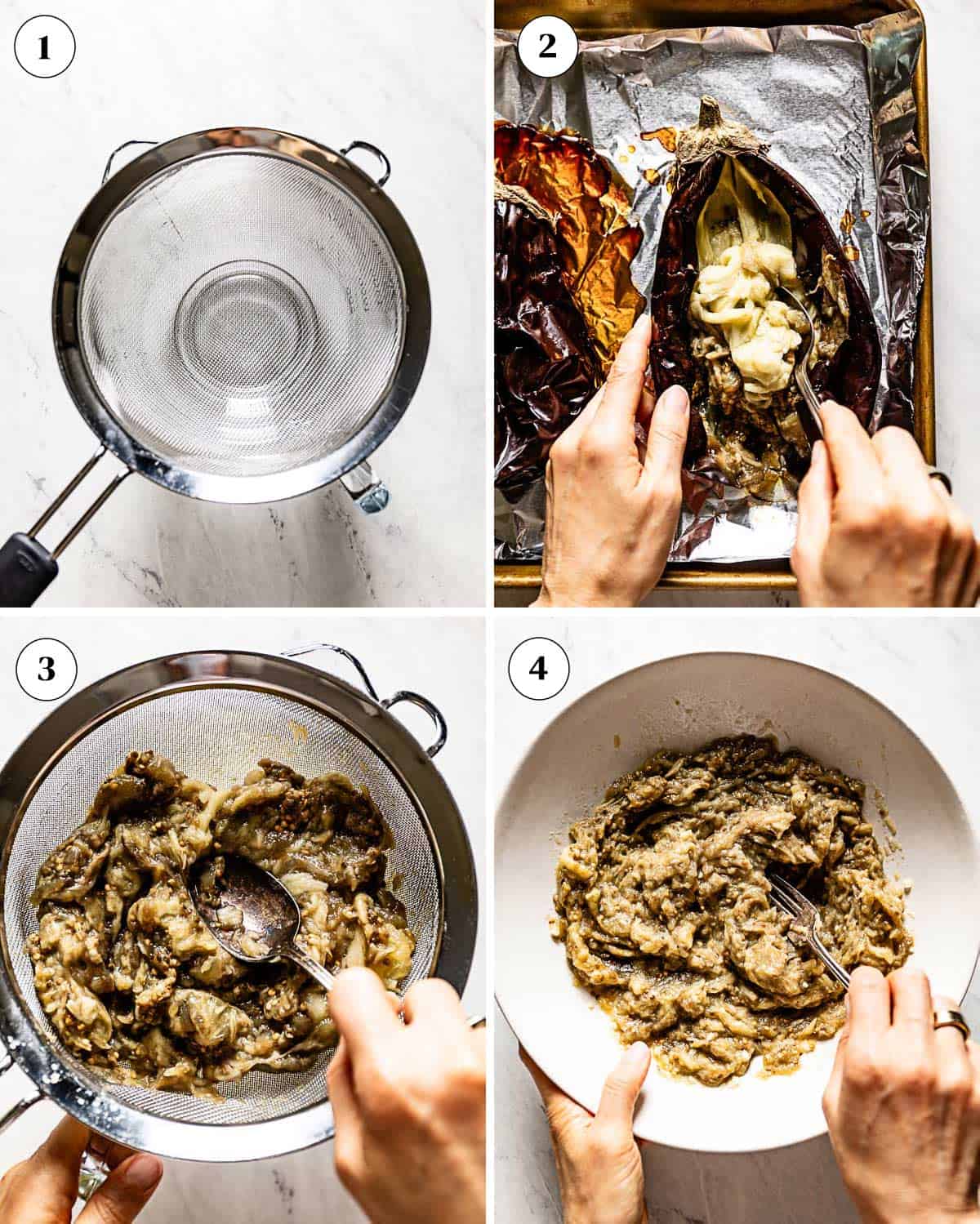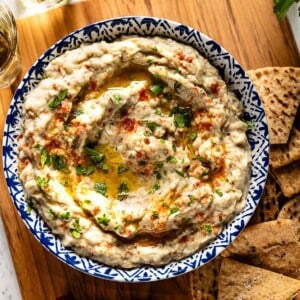If you are wondering, what is in baba ganoush, this savory, smoky spread generally consists of roasted eggplant, creamy tahini, zesty lemon juice, rich olive oil, and bold garlic. However, many also add unique blends of seasonings to give this Middle East eggplant dip a tantalizingly complex flavor profile.
Eggplant: There are many eggplant varieties to choose from when selecting a baba ganoush eggplant. Plump and round, globe eggplants are an excellent option for this recipe and are the easiest type to find in most American grocery stores. However, if you can get your hands on Italian eggplants, I highly recommend them, as this variety has a more tender flesh, fewer seeds, and a deliciously sweet flavor. Japanese eggplants will also work, but you’ll need more (7-8) due to their thinner shape and smaller size. If you’d prefer not to work with fresh eggplants, you may also use canned roasted eggplant (affiliate link), though it may not have the same tenderly mild flavor. Fresh garlic cloves Fresh lemon juice Sesame Tahini: Ground sesame paste, aka tahini, has an earthy, nutty flavor that perfectly balances the mild, smoky taste of roasted eggplant baba ganoush. My favorite tahini brand is Soom (affiliate link), which is incredibly smooth and creamy. Olive oil: I recommend using extra virgin olive oil for this recipe, as it has a higher quality with pure pressed olives, a lighter color, and a more neutral taste. Kosher salt Optional spices: While adding spices is not traditional to the original recipe, you can add more depth to your baba ganoush by adding a mixture of ground cumin and sweet, peppery paprika. For an extra deep taste, you may also use smoked paprika to complement your smoked eggplant baba ganoush. You can also add red pepper flakes for additional heat or black pepper for slightly pinier undertones. Garnishes: Topping this Mediterranean eggplant dip with different garnishes is a great way to revitalize your spread with sweet, crunchy, and fresh notes. For a tart, sweet finish, try topping your dip with pomegranate seeds, or use sesame seeds and pine nuts for a nuttier taste. Or, if you want bright, fragrant overtones, fresh herbs like parsley are some of my go-to’s.
How to Cook Eggplant for Baba Ganoush?
There are three different ways to prepare your eggplant for this simple recipe, depending on your preferred cooking method: roasted, charred, and grilled eggplant for baba ganoush.
Roasting Eggplant in the Oven
Roasting eggplant for baba ganoush is a cinch when you use my foolproof method for preparing Whole Roasted Eggplant. These instructions will ensure your eggplants come out tender and creamy with little prep time.
Char Eggplant On a Gas Stove
The most authentic way to prepare eggplant for this baba ganoush recipe is by charring it over the open flame of a gas stove. Making Roast Eggplant on a Gas Stove is quicker than other cooking methods and will result in a smoky baba ganoush recipe with an irresistibly complex, aromatic flavor.
Grill Eggplant
Learning how to grill eggplant for baba ganoush is an easy way to give this Mediterranean dip its classic rich, smoky flavor and smooth texture. Here’s how to do it:
How to Make Baba Ganoush?
There’s no secret to making an authentic baba ganoush recipe. These foolproof instructions will ensure your tastebuds explode with fresh, Mediterranean flavors in just eight basic steps.
Make ahead: You can make this baba ganoush recipe up to four days in advance. Then, store your prepared baba ghanoush in an airtight container in the fridge until ready to eat. Store: You can store your freshly made eggplant garlic dip in an airtight container in the refrigerator for up to four days. Freeze: While you can technically freeze this vegan baba ganoush recipe, please keep in mind that it will likely lose its creamy texture after it is exposed to freezing temperatures, so it might not taste as good after storage. However, if you still want to freeze, first transfer the mixture into an airtight container, removing as much air as possible. Then, store your baba ganoush in the freezer for up to one month. Thaw: Thaw your frozen aubergine dip in the fridge overnight. Because your mixture will likely become watery the longer it sits, drain it of excess liquid, taste for seasoning, and add more if necessary before serving.
What to Serve with Baba Ganoush?
One of the best things about preparing babaganoush is the many delectable ways to serve it. Though many traditionally serve this dish alongside pita triangles or vegetables, it also works as a tasty spread on toast, sandwiches, wraps, and more.
Bread: Who can say no to an appetizer as effortless and tasty as this? Serve a bowl of this popular Middle Eastern dip with your favorite pita chips, roasted pita wedges, or crackers, and you’ll have the perfect crowd-ready snack. Raw vegetables: Crisp, nutritious, and garden-fresh, fresh veggies make an incomparable pair with a bowl of smoky eggplant dip recipes. My favorite raw vegetables include cucumber slices, carrot sticks, cherry tomatoes, and sliced radishes. Other Middle Eastern or Mediterranean dips: Wondering what to do with baba ganoush that will make even the pickiest eaters hungry for more? Try pairing your creamy eggplant dip with other classics, like Mediterranean Hummus, Muhammara, and Tzatziki. To transform this simple spread into a next-level meze platter, you can also serve them with a side of olives and nuts—gorgeous and delicious. Grilled or roasted meats: A tasty way to serve baba ganoush is as a light, creamy side dish for hearty protein mains. For a classic Middle Eastern pairing, serve it alongside brightly spiced Chicken Shish Tawook or Oven Chicken Kabobs. Or, if you want an irresistibly juicy, perfectly portioned poultry meal, try this simple dish with Grilled Cornish Game Hens. Use it as a topping: A dollop of baba ganoush is an excellent topping for homemade CAVA bowl and pairs beautifully with honey harissa chicken or grilled harissa chicken.
Roasting time might change based on the sizes of your eggplant: Depending on the size and variety of your eggplant, they may need more or less cooking time. Japanese eggplants are smaller and thinner, requiring less time on the stove/grill, while globe eggplants are larger and may need more time to develop tender insides than other types. In total, however, you should have about 17 ounces (~480 gr.) of cooked eggplant flesh to make this babaganoush recipe. Eggplant seeds: Globe eggplants tend to have a lot of seeds—more than Italian eggplants. Though these seeds are entirely edible and blend into the dip after everything is mixed, you may remove them if you are not a fan. Roasted eggplant skin: It is totally okay if some of the charred eggplant skin goes into the mixture. While we want to remove as much of the skin as we possibly can, the eggplant skin is edible, so don’t worry about it if some skin gets mixed into your baba ganouj. Don’t skip the draining: The secret to an epic baba ganoush recipe is to remove as much liquid as possible from the eggplants after they are cooked. Not only do not skip this step but also take your time to ensure that the juices are fully drained as much as possible to ensure it is as creamy and tasty as possible. Add the oil in a steady stream: When adding the tahini and olive oil to the mixture, it is imperative to drizzle them in a steady stream while you are vigorously mixing the eggplant mixture. If you add them at the same time, they will not mix properly, and you’ll most likely end up with a less creamy and smooth baba ganoush. Taste for seasoning: One other important tip for making the best baba ganoush recipe is tasting the mixture for seasoning before serving. I cannot stress this step enough, as it’s vital that you adjust the taste of your spread to your liking. Add more salt, cumin, or paprika to achieve a more robustly flavored dip, or if you prefer a more acidic, tart flavor, add more lemon juice. Let it rest: Letting your eggplant baba ganoush rest for thirty minutes will allow its flavors to mix and develop, giving every bite a rich, Middle Eastern flavor. While it is an optional step, if you do have the time, let it rest in the fridge before serving. Baba ganoush without Tahini: If you are not a fan of tahini, you can use an equal amount of plain Greek yogurt for a different but equally delicious version of this recipe. For the iconic smoky taste: If you want to give your roasted eggplant spread an authentically smoky, robust taste, I highly recommend charring your eggplants over an open flame. Whether you cook them on a gas stovetop or on the grill, the smoky flavor that comes from the charred eggplants is worth the effort and time, especially if you are after the traditional baba ganoush recipe you enjoy in Middle Eastern restaurants. Food processor or blender: Though not a traditional preparation method, you may use a food processor or blender to make an easy baba ganoush without heavy mixing. Simply fit your food processor with a steel blade and place the roasted eggplant flesh, garlic, lemon juice, tahini, olive oil, salt, ground cumin, and paprika (if using) in the bowl. Pulse 7-9 times until thoroughly combined or longer, depending on how smooth you want the texture of your dip to be. Then, transfer the mixture to a bowl, garnish it with fresh parsley and a drizzle of olive oil, and serve.
Turkish Stuffed Eggplant Ratatouille Air-Fried Eggplant Eggplant Parm

